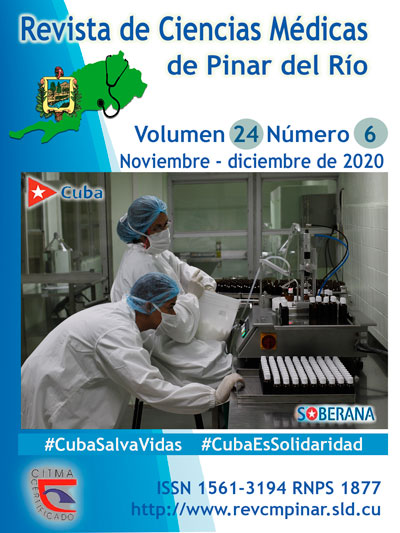Behavior of genodermatoses in San Juan y Martinez municipality
Keywords:
GENODERMATOSIS, BEHAVIOR, GENETICS.Abstract
Introduction: genetic diseases and congenital defects constitute the second cause of death only in the child of one year; these diseases can be of chromosomal, multifactorial and monogenetic origin. Genodermatoses are included in the last one, where the early diagnosis influences on the prognosis of life of the genetic carrier.
Objective: to characterize the behavior of genodermatoses in San Juan y Martinez municipality in the period 2018-2019.
Methods: a descriptive, cross-sectional research was conducted, with a target group comprising 476 patients with genetic diseases and a sample of 40 patients with genodermatoses; working with the variables of age, sex, color of skin, family history, type of genodermatosis and type of hereditary patterns, through the collection of data for the review of clinical histories.
Results: it was recorded that 83,3 % belonged to male sex, white skin color prevailed (78 %), 29 patients had no family history, ichthyosis (27,5 %) predominated, and autosomal dominant hereditary pattern was the most frequent (70 %).
Conclusions: genetic diseases are gaining a greater position in society every day, as a result preventive actions must be taken, starting from the Primary Health Care in order to counteract its incidence and improve the quality of life of the patients.
Downloads
References
1. Marcheco Teruel B. El Programa Nacional de Diagnóstico, Manejo y Prevención de Enfermedades Genéticas y Defectos Congénitos de Cuba: 1981-2009. Revista Cubana de Genética Comunitaria. 2009; 3(2-3): 167-184.
2. Ehara Y, Yamamoto O, Kosaki K, Yoshida Y. Natural course and characteristics of cutaneous neurofibromas in neurofibromatosis 1. J Dermatol [Internet]. 2018 Jan [citado 19/03/2019]; 45(1):53-57. Disponible en: https://pubmed.ncbi.nlm.nih.gov/28891076/
3. Remillieux M, Durand C, Sartelet H, Piolat C, Bourgeois E, Pommier P, et al. Type 1 neurofibromatosis: Onset of two tumors before the age of 5 years. Arch Ped [Internet]. 2017 Oct [citado 19/03/2019]; 24(10): 986-990. Disponible en: https://pubmed.ncbi.nlm.nih.gov/28870819/
4. Sánchez Galbán L, Díaz Leonard D, Betancourt Trujillo M. Poroqueratosis. Presentación de un caso. Medisur [Internet]. 2017 [Citado 04/02/2019]; 15(4):522-7. Disponible en: http://scielo.sld.cu/scielo.php?script=sci_arttext&pid=S1727-897X2017000400010&lng=es
5. Acosta Rodríguez A, Martínez Navarro J, Fernández López E. Poroqueratosis actínica superficial diseminada. Rev Ciencias Médicas [Internet]. 2018 [Citado 04/02/2019]; 22(2):179-84. Disponible en: http://scieloprueba.sld.cu/scielo.php?script=sciarttext&pid=S1561-31942018000200022&lng=es
6. H Lu, Fang EF, Sykora P, Kulikowicz T, Zhang Y, Becker KG, et al. Senescence induced by RECQL4 dysfunction contributes to Rothmund–Thomson syndrome features in mice. Cell Death Dis [internet]. 2014 May [Citado 26/06/2018]; 5(5): e1226. Disponible en: http://www.ncbi.nlm.nih.gov/pmc/articles/PMC4047874/
7. Igarzabal Irizar A, Garcia Uzquiano R, Gorrotxategi Gorrotxategi P, Zabaleta Rueda A. Liquen estriado: presentación de un caso clínico y revisión de la literatura médica. Rev Pediatr Aten Primaria [Internet]. 2018 [Citado 28/03/2019]; 20(80): [Aprox. 7p.]. Disponible en: http://scielo.isciii.es/scielo.php?script=sci_arttext&pid=S1139-76322018000400009
8. Sánchez Linares V, Fernández Quiñones Y, González Torre A, Saez Beltrán N. Hiperqueratosis epidermolítica: presentación de caso. Rev Gaceta Médica Espirituana [Internet]. 2016 ene- abr [Citado 28/03/2019]; 18(1): [Aprox. 12p.]. Disponible en: http://scielo.sld.cu/scielo.php?script=sci_arttext&pid=S1608-89212016000100012
9. Hechavarria Pérez A, Acevedo Vega MA, Céspedes Ferrales M. Poroqueratosis de Mibelli. Rev Cubana Medicina General Integral [Internet] 2019 [Citado 28/03/2019]; 35(4): [Aprox. 6p.]. Disponible en: http://www.revmgi.sld.cu/index.php/mgi/article/view/1093/303
10. García Odio A, Rives González Y, Reina Arroyo AI, Álvarez Bolivar D. Embarazada con neurofibromatosis tipo 1. Rev Ciencias Médicas Pinar del Río [Internet]. 2016 sep- oct [Citado 28/03/2019]; 20(5): [Aprox. 9p.]. Disponible en: http://scielo.sld.cu/scielo.php?script=sci_arttext&pid=S1561-31942016000500016
11. Marzo Ramírez T, Guerrero Chávez L, Lacosta Zamora J. Neurofibromatosis tipo I: presentación de un caso. Rev Información Científica [Internet] 2019 may- jun [Citado 28/03/2019]; 98(3): [Aprox. 9 p.]. Disponible en: http://scielo.sld.cu/scielo.php?script=sci_arttext&pid=S1028-99332019000300395&lng=es&nrm=iso&tlng=es
12. Galvez-Marticorena B, Chambi-Torres J. Incontinencia pigmenti en Cajamarca: reporte de un caso en lactante. Rev Horizonte Médico [Internet]. 2015 jul- sep [Citado 28/03/2019]; 15(3): [Aprox. 3 p.]. Disponible en: https://pesquisa.bvsalud.org/portal/resource/pt/lil-781150
13. Scheffer IE, Berkovic S, Capovilla G, Connolly MB, French J, Guilhoto L, et al. ILAE classification of the epilepsies: position paper of the ILAE Commission for Classification and Terminology. Epilepsia [Internet]. 2017 [Citado 28/03/2019]; 58(4): [Aprox.10p.]. Disponible en: https://www.ncbi.nlm.nih.gov/pubmed/28276062
Downloads
Published
How to Cite
Issue
Section
License
Authors who have publications with this journal agree to the following terms: Authors will retain their copyrights and grant the journal the right of first publication of their work, which will be publication of their work, which will be simultaneously subject to the Creative Commons Attribution License (CC-BY-NC 4.0) that allows third parties to share the work as long as its author and first publication in this journal are indicated.
Authors may adopt other non-exclusive license agreements for distribution of the published version of the work (e.g.: deposit it in an institutional telematic archive or publish it in a volume). Likewise, and according to the recommendations of the Medical Sciences Editorial (ECIMED), authors must declare in each article their contribution according to the CRediT taxonomy (contributor roles). This taxonomy includes 14 roles, which can be used to represent the tasks typically performed by contributors in scientific academic production. It should be consulted in monograph) whenever initial publication in this journal is indicated. Authors are allowed and encouraged to disseminate their work through the Internet (e.g., in institutional telematic archives or on their web page) before and during the submission process, which may produce interesting exchanges and increase citations of the published work. (See The effect of open access). https://casrai.org/credit/



